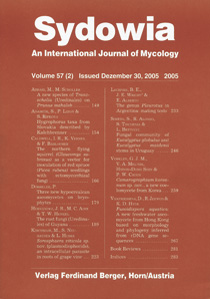
Fungal community of Eucalyptus globulus and Eucalyptus maidenii stems in Uruguay Simeto S., Alonso R., Tiscornia S. & Bettucci L. (2005) Fungal community of Eucalyptus globulus and Eucalyptus maidenii stems in Uruguay. Sydowia 57 (2): 246-258. The purpose of this research was to examine the fungal community of bark, sapwood and heartwood of Eucalyptus globulus ssp. globulus and E. globulus ssp. maidenii, two of the main species for pulp industry planted in Uruguay. Different trunk lesions are frequently found in E. globulus conversely to which is observed in E. maidenii growing in the same site. Slices from the basal portion of trunk were assessed for the fungal colonization. The main species that characterize these communities are the same but a low frequency of colonization in E. maidenii was remarkable. Sapwood showed the lowest and bark the highest frequency of colonization. Aureobasidium pullulans, Botryosphaeria spp., Cytospora eucalypticola, Basidiomycetes and sterile mycelia were the taxa present in almost all tissues of both hosts species. Several of these Basidiomycetes are frequently associated to Eucalyptus stumps. Simple correspondence analysis showed differences in community composition between bark and xylem from the two Eucalyptus species evidencing tissue but not host preferences. Several species present in these trunks were also found as endophytic colonizers of sprouting stumps, twigs and seedling stems of E. globulus. This indicates that these fungi could overcome the high stress conditions of mature trunk tissues and remain as latent colonizers. Keywords: endophyte, bark, sapwood, heartwood, wood rotting fungi. |
 |
Print ISSN: 0082-0598 |